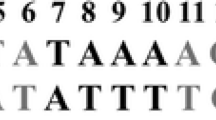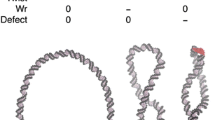Abstract
Hydrophobic forces play a crucial role in both the stability of B DNA and its interactions with proteins. In the present study, we postulate that the hydrophobic effect is an essential component in establishing specificity in the interaction transcription factor proteins with their consensus DNA sequence partners. The PDB coordinates of more than 50 transcription systems have been used to analyze the hydrophobic attraction of proteins towards their DNA consensus. This analysis includes computing the hydrophobic energy of the interacting molecules by means of their hydrophobic moments. Hydrophobic moments have successfully been used in previous studies involving self-assembly protein systems. In the present case, in spite of some variability, we found specificity in transcription factors when interacting with their respective consensus DNA sequences. By applying our model of biological membrane pattern for hydrophobic interactions, we postulate that hydrophobic forces constitute the necessary intermediate interaction between the unspecific electrostatic attraction for DNA phosphate groups and the very short-range interaction promoting hydrogen bonds. We conclude that hydrophobic interactions serve as the intermediate force guiding transcriptions factors towards the proper hydrogen bonds to their DNAs.




Similar content being viewed by others
Abbreviations
- H :
-
Hydrophobic moment vector
- enH :
-
Hydrophobic energy
- h+ :
-
Total hydrophobicity
- h– :
-
Total hydrophilicity
- r i :
-
Position vector of element i (amino acid or nucleotide)
- c +, c – :
-
Hydrophobic, hydrophilic centroids
- prot.:
-
Protein
- cons.:
-
Consensus motif DNA
- nucl.acid:
-
Nucleic acid
- PDB:
-
Protein data base
References
Boldina G, Ivashchenko A, Régnier M (2009) Using profiles based on nucleotide hydrophobicity to define essential regions for splicing. Int J Biol Sci 5:13–19
Chen S, White A, Love J, Murphy J, Ringe D (2000) Methyl groups of thymine bases are important for nucleic acid recognition by DtxR. Biochemistry 39:10397–10407
Chiu TP, Rao S, Mann RS, Honig B, Rohs R (2017) Genome-wide prediction of minor-groove electrostatic potential enables biophysical modeling of protein-DNA binding. Nucl Acids Res 45:12565–12576
Dickerson RE, Drew HR, Conner BN, Wing RM, Fratini AV, Kopra ML (1982) The anatomy of A-, B-, and Z-DNA. Science 216:475–485
Eisenberg D, Weiss RM, Terwilliger TC (1982) The helical hydrophobic moment: a measure of amphiphilicity of a helix. Nature 299:371–374
Eisenberg D, Weiss RM, Terwilliger TC (1984) The hydrophobic moment detects periodicity in protein hydrophobicity. Proc Natl Acad Sci USA 81:140–144
Feng B, Sosa R, Mårtensson A, Jiang K, Tong A, Dorfman K, Takahashi M, Lincoln P, Bustamante C, Westerlund F, Nordén B (2019) Hydrophobic catalysis and a potential biological role of DNA unstacking induced by environment effects. Proc Natl Acad Sci USA 116:17169–17174
Gukian KM, Schweitzer BA, Ren RX-F, Sheils CJ, Tahmassebi DC, Kool ET (2000) Factors contributing to aromatic stacking in water: evaluation in the context of DNA. J Am Chem Soc 122:2213–2222
Hancock SP, Stella S, Cascio D, Johnson RC (2016) DNA sequence determinants controlling affinity, stability and shape of DNA complexes bound by the nucleoid protein Fis. PLoS ONE 11:e0150189
Hummer G (1999) Hydrophobic force field as a molecular alternative to surface-area models. J Am Chem Soc 121:6299–6305
Israelachvili JM (2011) Intermolecular and surface forces, 3rd edn. Academic Press
Israelachvili J, Pashley R (1982) The hydrophobic interaction is long range, decaying exponentially with distance. Nature 300:341–342
Kielkopf CL, White S, Szewczyk JW, Turner JM, Baird EE, Dervan PB, Rees DC (1998) A structural basis for recognition of a•t and t•a base pairs in the minor groove of B-DNA. Science 282:111–115
Krieger E, Vriend G (2014) YASARA view—molecular graphics for all devices—from smartphones to workstations. Bioinformatics 30:2981–2982
Lin MS, Fawzi NL, Head-Gordon T (2007) Hydrophobic potential of mean force as a solvation function for protein structure prediction. Structure 15:727–740. https://doi.org/10.1016/j.str.2007.05.004
Makowski M, Czaplewski C, Liwo A, Scheraga HA (2010) Potential of mean force of association of large hydrophobic particles: toward the nanoscale limit. J Phys Chem B 114:993–1003
Malecka KA, Ho WC, Marmorstein R (2009) Crystal structure of a p53 core tetramer bound to DNA. Oncogene 28:325–333
Matys V, Kel-Margoulis OV, Fricke E, Liebich I, Land S, Barre-Dirrie A, Reuter I, Chekmenev D, Krull M, Hornischer K, Voss N, Stegmaier P, Lewicki-Potapov B, Saxel H, Kel AE, Wingender E (2006) TRANSFAC and its module TRANSCompel: transcriptional gene regulation in eukaryotes. Nucl Acids Res 34:D108–D110
McDonald IK, Thornton JM (1994) Satisfying hydrogen bonding potential in proteins. J Mol Biol 238:777–793
Meyer E, Rosenberg K, Israelachvili J (2006) Recent progress in understanding hydrophobic interactions. Proc Natl Acad Sci USA 103:15739–15746
Mozo-Villarías A, Querol E (2019) A protein self-assembly model guided by electrostatic and hydrophobic dipole moments. PLoS ONE 14:e0216253
Mozo-Villarías A, Cedano JA, Querol E (2003) A simple electrostatic criterion for predicting the thermal stability of proteins. Protein Eng 16:279–286
Mozo-Villarías A, Cedano JA, Querol E (2014) A model of protein association based on their hydrophobic and electric interactions. PLoS ONE 9:e110352
Mozo-Villarías A, Cedano JA, Querol E (2016) Vector description of electric and hydrophobic interactions in protein homodimers. Eur Biophys J 45:341–346
Mozo-Villarías A, Cedano JA, Querol E (2017) Self-assembly of open protein systems: a comprehensive view based on the interactions between 3d hydrophobic and electric dipole moment vectors. J Proteomics Bioinform 10:252–259
Pabo CO, Sauer RT (1992) Transcription factors: structural families and principles of DNA recognition. Annu Rev Biochem 61:1053–1095
Patel AJ, Varilly P, Jamadagni SN, Hagan MF, Chandler D, Garde S (2012) Sitting at the edge: how biomolecules use hydrophobicity to tune their interactions and function. J Phys Chem B 116:2498–2503. https://doi.org/10.1021/jp2107523
Petsko GA, Ringe D (2004) Bonds that stabilize folded proteins. Protein structure and function. New Science Press Ltd., London, pp 10–11
Reißer S, Strandberg E, Streinbrecher T, Ulrich AS (2014) 3D hydrophobic moment vectors as a tool to characterize the surface polarity of amphiphilic peptides. Biophys J 106:2385–2394
Richmond TJ, Davey CA (2003) The structure of DNA in the nucleosome core. Nature 423:145–150
Rohs R, Jin X, West SM, Joshi R, Honig B, Mann RS (2010) Origins and specificity in protein-DNA recognition. Annu Rev Biochem 79:233–269
Sarkar A, Kellogg E (2010) Hydrophobicity—shake flasks, protein folding and drug discovery. Curr Top Med Chem 10:67–83
Sauer RT (1995) Minor groove DNArecognition by α-helices. Nature Struct Biol 2:7–9
Silverman BD (2001) Hydrophobic moments of protein structures: spatially profiling the distribution. Proc Natl Acad Sci USA 98:4996–5001
Silverman BD (2003) Hydrophobic moments of tertiary protein structures. Proteins Struct Func Gen 53:880–888
Spolar RS, Record MT (1994) Coupling of local folding to site-specific binding of proteins to DNA. Science 263:777–784
Tolstorukov MY, Jernigan RL, Zhurkin VB (2004) Protein–DNA hydrophobic recognition in the minor groove is facilitated by sugar switching. J Mol Biol 337:65–76
Tsodikov OV, Biswas T (2011) Structural and thermodynamic signatures of DNA recognition by mycobacterium tuberculosis DnaA. J Mol Biol 410:461–476
Acknowledgements
This research was supported by Ministerio de Economía y Competitividad of Spain [BIO2017-84166R, BFU2013-50176-EXP and PID2020-116874R-100] and by the Centre de Referència de R+D de Biotecnologia de la Generalitat de Catalunya. We thank Mrs. Lynn Strother for revising the English text
Author information
Authors and Affiliations
Corresponding author
Additional information
Publisher's Note
Springer Nature remains neutral with regard to jurisdictional claims in published maps and institutional affiliations.
Supplementary Information
Below is the link to the electronic supplementary material.
Rights and permissions
About this article
Cite this article
Mozo-Villarías, A., Cedano, J. & Querol, E. The importance of hydrophobic interactions in the structure of transcription systems. Eur Biophys J 50, 951–961 (2021). https://doi.org/10.1007/s00249-021-01557-x
Received:
Revised:
Accepted:
Published:
Issue Date:
DOI: https://doi.org/10.1007/s00249-021-01557-x




